EDITOR’S NOTE: This week Steve Stanchfield takes a break from his weekly column to visit Los Angeles to dig through a few new archives. Filling in is our resident expert on industrial/educational/commercial films, Jonathan Boschen. Today, a look at Jerry Fairbanks – and one of his most intriguing films.
– Jerry Beck
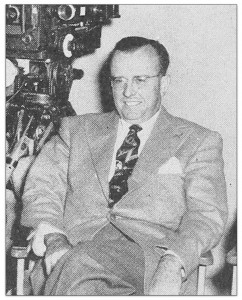
Jerry Fairbanks an iconic cinematographer, filmmaker, showman, producer and and contributor to our American Film History, was the executive producer of the film. (click to enlarge)
Though it was certainly not the first industrial film produced by the studio, it was produced at a time when Mr. Fairbanks was taking on an ambitious interest in the production of sponsored motion pictures. Most recently in 1946 Fairbanks formed Jerry Fairbanks Inc., the commercial division of his company Scientific Films Inc. to produce non-theatrical films for a variety of clients. To advertise this interest the studio produced and released in 1946 a rather fascinating self promotional film entitled Old Chinese Proverb that showcased the studio’s capabilities following World War II. “Inside Story of Modern Gasoline” being one of the studio’s early industrials was a beautifully polished production which not only featured nicely shot 16mm footage, but also extremely clever and fun cartoon animation. As a result, it is well remembered today by many for the show stealing animated molecules who narrate the film and discuss the benefactors of Red and White Crown Gasoline and how it is made from Crude Oil.
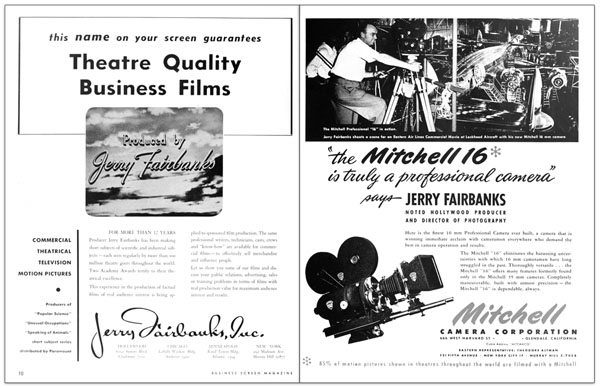
Two 1947 trade ads for Jerry Fairbanks Inc., the commercial non-theatrical division of Jerry Fairbanks’ Scientific Films. The ads were placed side by side like this in the 1947 Vol. 8 No. 7 issue of “Business Screen Magazine”. The Mitchell 16mm camera (seen right), was frequently used on many of Fairbanks’ industrial shoots. Interestingly, trade reviews for Fairbanks’ Standard Oil Indiana films credit the Standard Oil Indiana films for being the first public, non-military films, to employ the camera. (click to enlarge)
 The Inside Story of Modern Gasoline was one of two non-theatrical documentary films produced by Jerry Fairbanks Inc. that were commissioned by Standard Oil Indiana. The film along with it’s twin production Gasoline’s Amazing Molecules (currently missing as of June 2015) were produced to exploit the benefits of Standard’s Red Crown and White Crown gasoline brands, both of which apparently received a rebranding overhaul in 1947. The Inside Story of Modern Gasoline was made exclusively for internal showings to educate employees and franchise owners about the brands, while it’s nearly identical sister film Gasoline’s Amazing Molecules was prepared for public exhibition in communities that had a Standard Oil of Indiana gas station. The differences between the two films seem to only be with the opening credits and and how the narrator speaks to viewers, as both films have the exact same running time. The films were distributed in 16mm prints by the Public Relations Department of the Standard Oil Company of Indiana solely to Standard Oil Indiana gasoline station owners who would then exhibit Inside Story to their employees, and book public exhibitions of Gasoline’s Amazing Molecules at local community club meetings (i.e. Rotary Club), factories, and schools. To accompany public exhibitions, souvenir booklets featuring the film’s animated molecules discussing gasoline were handed out to viewers.
The Inside Story of Modern Gasoline was one of two non-theatrical documentary films produced by Jerry Fairbanks Inc. that were commissioned by Standard Oil Indiana. The film along with it’s twin production Gasoline’s Amazing Molecules (currently missing as of June 2015) were produced to exploit the benefits of Standard’s Red Crown and White Crown gasoline brands, both of which apparently received a rebranding overhaul in 1947. The Inside Story of Modern Gasoline was made exclusively for internal showings to educate employees and franchise owners about the brands, while it’s nearly identical sister film Gasoline’s Amazing Molecules was prepared for public exhibition in communities that had a Standard Oil of Indiana gas station. The differences between the two films seem to only be with the opening credits and and how the narrator speaks to viewers, as both films have the exact same running time. The films were distributed in 16mm prints by the Public Relations Department of the Standard Oil Company of Indiana solely to Standard Oil Indiana gasoline station owners who would then exhibit Inside Story to their employees, and book public exhibitions of Gasoline’s Amazing Molecules at local community club meetings (i.e. Rotary Club), factories, and schools. To accompany public exhibitions, souvenir booklets featuring the film’s animated molecules discussing gasoline were handed out to viewers.
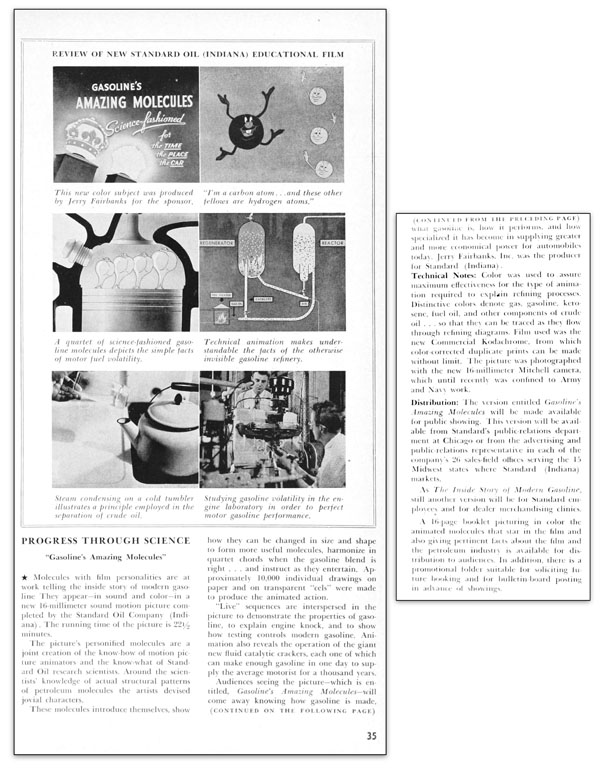
A Trade review for “Gasoline’s Amazing Molecules”, the public version of “Inside Story of Modern Gasoline” from the 1948 Vol. 9 No. 7 of Business Screen Magazine (click to enlarge). As “Gasoline’s Amazing Molecules” was available to the public, it received more attention than it’s internal brother “The Inside Story of Modern Gasoline”. Unfortunately the review for the film(s’) from Chemical News Parade is not present, however it can be purchased and read from the American Chemical Society: http://pubs.acs.org/doi/abs/10.1021/cen-v026n048.p3564
Both films were well received by viewers and also by various different industry trade magazines such as Business Screen Magazine and the Chemical News Parade. The reviews praised the use of the animated cartoon molecules to discuss gasoline, and also the use of color in the cartoon and Technical animation to depict certain molecules pertaining to crude oil. As stated by the reviews, the animation was a ‘joint creation’ of oil research scientist and also the animators of the Jerry Fairbanks studio to ensure that the film would be effective and educational to audiences. In addition, the magazines also applauded the films for successfully breaking down and making it easy for viewers not familiar with Gasoline to understand the various different technical aspects regarding it.
Unfortunately one detail which is absent from the reviews and from both films are credits indicating who was responsible for working on the films. As a matter of fact, Jerry Fairbanks himself is technically not even credited on either films as the company name, Jerry Fairbanks Inc., is credited. However from watching the studio’s promotional piece “Old Chinese Proverb” and viewing several of the Fairbanks’ Paramount short subjects of the same time one can piece together who may have worked on the Standard Oil Indiana films.
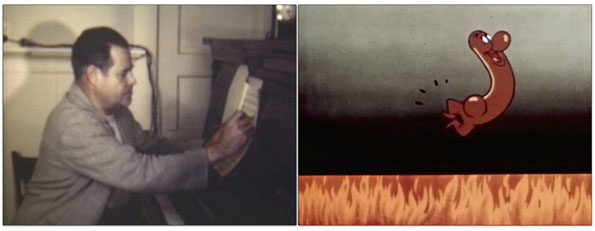
Edward Paul the musical director for Jerry Fairbanks at work composing another score, as depicted in “Old Chinese Proverb”. On the right, the Fuel Oil Molecule goes into it’s oil cracking dance set to a juiced-up rendition of “Turkey in the Straw”. As seen and heard here, Paul’s scores had a tendency of being very animated and as a result were fun pieces of music that emphasized and brought life into what could’ve been boring subject matter.
The musical score to the Standard Oil Indiana productions, which is an entertaining composition of it’s own, was composed by Edward Paul. Paul was the musical director at Fairbanks’ studio and was responsible for nearly all of the studios films. His Fairbanks scores tended to be well animated and frequently incorporated classical music, folk tunes, and other public domain material along with his own original work to enhance the films. One specific example of how Paul’s score brings out the details in The Inside Story of Modern Gasoline is the segment in which when the various different animated relatives of the Gasoline Molecule introduce themselves, as different original musical cues are used to emphasize their appearances, shapes, and characteristics. Other animated scenes throughout the film make use of variations of well known tunes such as Ding Dong Bell Puss Fell In The Well, Turkey In The Straw, and Mary Had A Little Lamb to emphasize certain details.
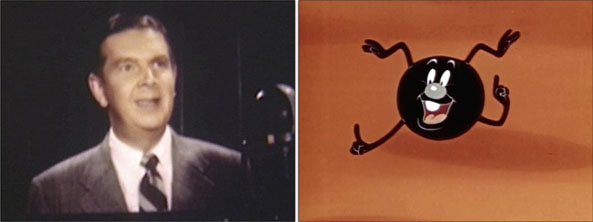
Ken Carpenter recording narration for a Jerry Fairbanks’ film as seen in “Old Chinese Proverb”. Carpenter provided his voice to the Carbon Atom (seen right), who narrates the vast majority of the film and gives viewers the inside story on modern red and white crown gasoline.
The Narration and voices in the film were contributed by a variety of different people. The narration, or more appropriately carbon-atom’s voice, was done by Ken Carpenter. Carpenter frequently narrated many of Fairbanks’ Paramount shorts and also narrated various industrial films made by Jerry Fairbanks. In addition he also did narration work for other studios such as the Jam Handy Organization and contributed his talents to a variety of different popular radio programs of the era. In terms of who voiced the other molecules it’s not quite known at the moment who did them, however it has been suggested that Stan Freberg may have contributed these assets to the the film. (Around this time, Freberg was providing his vocal talents to the studio’s highly popular Speaking Of Animals comedies.)

(Cropped) film stills showing the various different Hydro-Carbon relatives, that are derived from Crude Oil. From left to right, the ‘Typical’ Gasoline Molecule, another type of Gas Molecule, the Kerosene Molecule, a Fuel Oil Molecule, a Light Lubricating Oil Molecule, a Heavy Lubricating Molecule, and a Residual Materials Molecule. It has been suggested that Stan Freberg was responsible for providing the voices to these individual characters. Note how each molecule is a distinctive color; this trait is extremely important throughout the film, as color would be used in all of the animation segments to demonstrate how crude oil is broken down and harvested into different molecules. (click to enlarge)
Aside from the music and narration is when the credits start to get a little iffy. However, one individual who certainly had a role in the production of both Standard Oil Indiana films is Lou Lilly, who is credited along with Jerry Fairbanks in the film’s original copyright catalogue entry. It’s not specifically known what Lilly was responsible for, but it is very well possible that he was the producer and/or director of the film and possibly in charge of directing the animation. Four years earlier (1944), Lilly joined Fairbanks’ studio as an ‘animated cartoon expert’ to work as a production manager on several of the Speaking Of Animals comedies. Prior to joining, Lilly worked in the story department of Leon Schlesinger Productions Inc. and also worked for (Columbia Pictures) Screen Gems Inc., as an animation director. Lilly’s resume certainly does support the theory of possibly being the animation director. One other individual who may have worked on the animation was a lady named Anna Osborne. Around 1947 and 1948 Osborne was the head animator at the studio and was often credited on the Speaking of Animals entries for animating and executing Fairbanks’ patented Duoplane animation process (a special animation process, which made live action animals in films talk).

Two technical animation scenes. Color, Kodachrome in this case, was put to full use as an educational aid as various different colors were used to identify the different components found in Crude Oil.
So here is the entertaining, and still educational The Inside Story Of Modern Gasoline. This particular print comes from the courtesy of Rick Prelinger and Prelinger Archives, which is available for downloading.
(After viewing the film, one must wonder why the studio never pursued an interest in the production of theatrical cartoons. They certainly could have pulled it off with their animation department and Edward Paul’s musical scores…)
In addition, here is a video production I produced exploring the history of Inside Story of Modern Gasoline.
(A Special Thank you to Jerry Beck, Don Yowp, and Rick Prelinger for assistance with the research to this article and also to my video project pertaining to “The Inside Story of Modern Gasoline”.)


 Jonathan A. Boschen is a professional videographer and video editor, who is also a film and theatre historian. His research deals with pre-1970s movie theaters in New England and also film history pertaining to the Jam Handy Organization, Frank Goldman, Ted Eshbaugh, Jerry Fairbanks, and industrial films. (He is a huge fan of industrial animated cartoons!). Currently, Boschen is working on a documentary on the iconic Jam Handy Organization.
Jonathan A. Boschen is a professional videographer and video editor, who is also a film and theatre historian. His research deals with pre-1970s movie theaters in New England and also film history pertaining to the Jam Handy Organization, Frank Goldman, Ted Eshbaugh, Jerry Fairbanks, and industrial films. (He is a huge fan of industrial animated cartoons!). Currently, Boschen is working on a documentary on the iconic Jam Handy Organization.






















































I will always remember Jerry Fairbanks fondly for the help that he gave me in writing one of my earliest professional articles; the two-part history of the “Crusader Rabbit” TV cartoons, “2½ Carrots Tall: TV’s First Animated Cartoon Star” in “Comics Scene” #6 (November 1982) and #7 (January 1983). By then Fairbanks was in his late 70s, in a small office on the outskirts of Hollywood; he must have been on the verge of retirement. He told me that he was never involved in their production by Alex Anderson’s & Jay Ward’s TAP studio in San Francisco; just their post-production and marketing from Hollywood – although he did remember the frequent business trips that Jay Ward made from San Francisco to Hollywood, mostly to discuss how Fairbanks was doing in getting more money for their production from NBC. Fairbanks didn’t really remember much – but he gave me full access to his large scrapbooks! He had documented everything about his “Crusader Rabbit” marketing, so I could tell when Anderson & Ward first came to him in 1948; all of his unsuccessful sales pitches during 1949 and early ’50 (he had tried to promote the very limited animation as a marvelous new invention, “the Teletoon process”, in a January 1949 press release – doubtlessly the first appearance of Teletoon); getting a TV sponsor (Carnation) and the first TV sale of 130 5-minute episodes to KNBH in Los Angeles, to air beginning August 1, 1950; his attempts to renew the series (successful for 65 more episodes during 1951, then NBC dropped it); his disastrous purchase of the 195 episodes from NBC to syndicate them himself, which didn’t bring in enough money to cover the payments to NBC, which foreclosed on the cartoons and sold them to Shull Bonsall, at which point Fairbanks’ records ended.
There was almost no information about “Crusader Rabbit” in 1980, only conflicting guesses that it had appeared sometime, somewhere, between 1948 and 1951. My article was the first solid documentation that it got — thanks to Fairbanks’ meticulous record-keeping, and his giving me free access to his scrapbooks. There were several samples of a proposed “Crusader Rabbit” newspaper comic strip, I think by Alex Anderson himself. (Jay Ward couldn’t draw. He was originally the TAP business manager, who got really involved with “Crusader Rabbit” — he named the series & character and suggested gags, and turned out to be a talented voice director.) Too bad it didn’t sell.
Say, Kerosene, are you glad to see us?? 😀
I’ve always enjoyed Fairbanks cartoons… Don M.Yowp wrote as “Dodswoth the Cat” on the Prelinger site that Frank Nelson does one of the molecules (well, Mr. Nelson also did work for rival John Sutherland…)
The “fuel oil” molecule and the “heavy oil lubricating molecule” are both Frank Nelson, as best as I can tell.
I agree about Frank Nelson, but I wish I could say with certainty who were the other two character men. At the time (1947-48) Fairbanks employed Freberg, Harry Lang, Jack Mather, John T. Smith and Daws Butler on various SPEAKING OF ANIMALS, along with Carpenter as narrator. But I can’t say I definitely hear any of them…the closest I can offer is “Gas” and “Kerosene” sound like Don Messick, Stan Freberg might be the “light lubricating” guy, and the deepest one sounds like Ken Carpenter doubling. I know the opening narrator too, but for the life of me can’t say who he is. I can at least add that they hired the Sportsmen quartet to sing their standard “Hmmmmm” note which they did weekly at the time on the BENNY radio show. And the on-camera engineer who does the demonstration about fuel knocks is John “Bud” Hiestand, a very busy radio announcer who was the announcer of The Mel Blanc Show, The Cinnamon Bear, Mickey Mouse radio show and tons more. He narrated many of the John Sutherland shorts. Wish we could find paperwork for the Fairbanks studio…I wonder if he donated it to a research library?
Wish we could find paperwork for the Fairbanks studio…I wonder if he donated it to a research library?
I believe UCLA has his studio’s files.
I do know that UCLA has the majority of the studio’s files. Unfortunately though I live on the other side of the country, and can’t access them at the moment. One of these days I’ll get out to there to look at the collection…
I hope you will.
Hello
I have one of these 16mm Kodachrome shorts “The Story Of Lubricating Oil”
nice print that belonged to Jerry Himself. I came into possession of most
of his film vault, after he passed and his wife let everything go! 35mm & 16mm
negatives, personal prints, outtakes you name it. Some we gave to USC film
Archives. I sold off hundreds of prints and negatives, then this is what I saved.
I will be selling these off too, if your are interested the IB Tech cartoons are amazing
color!
Jerry Fiarbanks Motion Picture Films 16mm & 35mm 9/9/2012 – REVISED INVENTORY 10/17/17
826 North Cole Avenue, Hollywood CA.
“An Answer For Linda” Calc Version
16mm Eastman color release print #140C-2A EKC
“Big Delivery Wagon” 1950
IB-Technicolor Dye Transfer Print (2 prints) 16mm
PUBLIC PROSECUTOR SERIES NBC
The Case Of The…
1. #5 “Strange Suicide” 20 min. version 1948
2. #9 “Missing Hour” 20 min, version 1948
both reduction prints from 1948!
“The Story Of Lubricating Oil” 1948?
16mm Kodachrome print
“Time Telling Through The Ages” US Time (produced in 1949)
16mm Kodachrome protection masters
Rolls 1 & 2 rolls 1 & 3 (2 cans) 4 rolls.
“We Learn About The Telephone” 1965
(April 1965) 22 minutes
IB-Technicolor Dye Transfer Print 16mm
Color Short Cartoons John Sutherland Productions 9/10 minutes each 16mm
“The Devil And John Q” 1952
IB-Technicolor Dye Transfer Print
“Make Mine Freedom” 1948
2-25-48
Harding College (MGM)
IB-Technicolor Dye Transfer Print
“Meet King Joe” 1951
(9-13-51)
IB-Technicolor Dye Transfer Print
“Why Play Leapfrog” 1950
January 1950
Eastman color
END LIST
Does anyone here recall working with or have any information on Bill Bosche´ , assistant animator at Jerry Fairbanks studio in the 1940’s (before the war)? He went on to work for Walt Disney for 30 years.